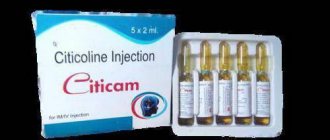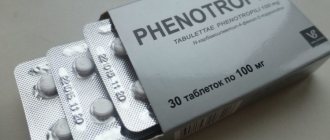There are restrictions during pregnancy
Has restrictions when breastfeeding
Has restrictions for children
Has limitations for liver problems
Has limitations for kidney problems
For various reasons, many people cannot cope with stress and need treatment with drugs that normalize their mental state. One of the most commonly used drugs in this group is Sertraline, which, according to the instructions for use, helps overcome depression and is also used in the treatment of phobias, post-traumatic stress disorder, anorexia and bulimia. According to medical research, it is one of the best medicines in psychiatry and neurology.
Sertraline medicine packaging
General information about Sertraline
It is a new generation medicine that has high rates of effectiveness and does not cause addiction or the development of dependence in people taking it.
Sertraline (INN – Sertralirum) is part of the pharmacological group of antidepressants. In psychiatry it is used to treat depression, panic conditions and other diseases.
Release forms and prices for the drug, average in Russia
The medication is produced in the form of white film-coated tablets in two dosages: 50 mg and 100 mg. Sold in blisters of 30 pcs. in cardboard packaging. Today, this drug is not on sale in Russia, but you can buy its analogues with the active ingredient sertraline.
| Name | Sertraline dosage, mg | Quantity, pcs. | Manufacturer | price, rub. |
| Zoloft | 50 | 28 | Pfizer, USA | 914 |
| Zoloft | 100 | 28 | Pfizer, USA | 1199 |
| Stimuloton | 50 | 10 | Egis, Hungary | 375 |
| Stimuloton | 100 | 30 | Egis, Hungary | 902 |
| Serenata | 50 | 30 | Torrent, India | 576 |
| Serenata | 100 | 30 | Torrent, India | 1046 |
Since the price range is quite wide, you can choose the drug according to your financial capabilities, but you should consult your doctor before taking it.
Composition and pharmacological properties
The basis of the drug is sertraline hydrochloride, which is the active ingredient. Its amount depends on the dosage of the drug - 50 or 100 mg.
Auxiliary components: stearic acid, silicon dioxide, corn starch, croscarmellose sodium.
The drug enhances the functioning of the neurotransmitter due to the reuptake of serototin in the brain. It also blocks the uptake of serotonin into platelets. As a result of this process, the excitability of certain zones of neurons in the midline of the medulla oblongata decreases. Sertraline does not affect psychomotor function, and it remains unchanged during the period of taking the medication and after its discontinuation. Patients observe improvement within a week of use, and the maximum effect is achieved as a result of systematic use for several weeks.
The drug has high absorption rates, but absorption occurs rather slowly, which is why the active substance reaches its maximum level in the blood plasma approximately on the 14th day of administration.
Protein binding in the blood occurs 98%, and the half-life is 30 hours. The breakdown of the substance occurs in the liver, and after transformation it is excreted through the kidneys and slightly through the feces. Patients with liver diseases should pay attention to increasing the period of elimination of the drug from the body and adjust the dose.
See also:
Instructions for use of Trittico and reviews of patients taking the drug
special instructions
During the treatment period, it is necessary to strictly monitor the behavior of patients in a state of depression (risk of suicide attempts) until significant improvement occurs as a result of the treatment. Sertraline is prescribed no earlier than 14 days after discontinuation of MAO inhibitors. Women of childbearing age should use adequate contraception during treatment. During the treatment period, care must be taken when driving vehicles and engaging in other potentially hazardous activities that require increased concentration and speed of psychomotor reactions.
Indications and contraindications for taking Sertraline
Sertraline is used for the treatment and prevention of various conditions associated with mental disorders in patients. Main indications for taking the drug:
- depression, including those associated with suicidal tendencies and anxiety;
- panic attacks of various types;
- post-traumatic stress and other disorders associated with it;
- obsessive-compulsive syndrome;
- various social phobias;
- treatment of anorexia and bulimia, which arose against the background of a nervous disorder.
It is important to note that the medication has a mild effect and usually there is no exacerbation at the initial stage of taking this antidepressant.
There are some contraindications to taking Sertraline:
- age up to 6 years;
- periods of pregnancy and pregnancy;
- epilepsy, especially in acute form;
- simultaneous use with MAO inhibitors;
- hypersensitivity to the substance sertraline;
- combination with drugs containing the substances tryptophan, pimozide and phenylfluramine.
Additional consultation with a doctor is also necessary for patients with various liver diseases and those suffering from anorexia.
See also:
Instructions for use of Citalopram, reviews of the drug from patients and doctors, its analogues
Shown
- Major depressive disorder; atypical depression with hypersomnia, increased appetite;
All indications except GAD are approved by the FDA.
Potential offline uses: patients with frailty (without depression), patients who want to avoid hyperprolactinemia (prepubertal adolescents, women with galactorrhea, unexplained amenorrhea, menopause without hormone replacement therapy) - sertraline does not increase prolactin, unlike other SSRIs.
Instructions for use of Sertraline
Sertraline is taken orally, preferably with food for better absorption. The dosage is adjusted depending on the disease and age of the patient.
Dosage
For adults, the daily dose of the drug at the initial stage of therapy is 25 mg and gradually increases to 50 mg a week after the start of treatment. The effect of the medication is noticeable after 14 days; if the effect does not appear, the dosage can be increased and divided into several doses, but not more than 200 mg per day. Side effects may occur with a significant increase in dose.
For panic disorders, 25 mg of the drug per day is prescribed and the dose is increased to 50 mg until the condition improves, after which the dosage is reduced to maintain the therapeutic effect.
For the treatment of patients with liver and kidney diseases, lower doses of the drug are prescribed, which are divided into several doses.
For children under 12 years of age, the standard dosage is 25 mg per day; at the age of 12-18 years, you can take up to 50 mg per day, if there are no deviations in weight, otherwise the doctor will select an individual regimen.
For elderly patients, a standard course of therapy is suitable, as for all adult patients. The general course of treatment to maintain the therapeutic effect is 2-3 months.
special instructions
Despite the fact that the antidepressant is recognized as effective and usually does not cause addiction, there are risk groups that should be taken into account when prescribing and taking the drug:
- People who are suicidal should be under constant supervision during treatment. Sometimes hospitalization is required.
- Patients with depression may develop mania while taking the medication.
- It is not recommended to prescribe the drug to patients with epilepsy.
- If patients have metabolic disorders, the dose of the drug should be adjusted and the body's reaction to it should be closely monitored.
- It is recommended to avoid driving vehicles during the course of therapy.
- There is no reliable data on the effect of Sertraline on the development of the fetus and newborn, so it should not be taken by pregnant and nursing mothers.
- Use in pediatrics has been superficially studied; use is not recommended for children under 6 years of age.
Sertraline should not be taken with alcohol, as it can cause an uncontrollable mental state, even when taking minimal doses.
Possible side effects and overdose
A course of therapy with Sertraline is associated with the risk of side effects from different body systems:
- CNS: headache, insomnia, weakness, dizziness;
- CVS: chest pain, pressure surges;
- digestive system: nausea, diarrhea, stomach cramps, vomiting, constipation;
- reproductive: anorgasmia, decreased potency, but rarely recorded;
- allergic reactions: redness, itching, fever.
Weight loss, increased sweating and obsessive thoughts are also possible; if any of the above conditions occur, you should immediately tell your doctor.
An overdose is possible if the daily dose of the drug is exceeded; in such cases, there is a possibility of serotonin syndrome. It is associated with nausea, vomiting, drowsiness and loss of coordination. A state of overexcitation and thoughts of suicide arise.
To get rid of the consequences of an overdose, it is necessary to rinse the stomach, take activated charcoal, clear the airways and monitor the functioning of the heart and liver in a stationary mode.
Drug interactions
Sertraline reacts with other medications; some combinations may worsen the condition and create additional health problems:
- If the patient is taking tricyclic antidepressants, at least 14 days must pass before starting Sertraline.
- A characteristic consequence of the interaction of sertraline with lithium preparations is a high probability of tremor.
- MAO inhibitors, when interacting with the substance seratraline, cause serotonin syndrome.
- Concomitant use with warfarin leads to an increase in prothrombin time.
- Tryptophan and fenfluramine are components with which sertraline cannot be combined due to the occurrence of unexpected reactions from the nervous system.
If there is a need to replace one antidepressant with another, you should not do this abruptly; you must consult a specialist.
See also:
Instructions for use of Noofen, drug analogues and reviews after use
Drug interactions
When taken simultaneously with monoamine oxidase blockers, severe complications arise. When taking MAOIs after antidepressant therapy, death can occur in rare cases.
Concomitant use of Serenate with MAOIs causes rigidity, muscle cramps, hyperthermia and instability of the autonomic nervous system.
Article on the topic: Alcoholic polyneuropathy - causes, forms of the disease, treatment and prognosis
When used simultaneously with coumarin derivatives, the prothrombin time sharply increases. Cross-administration of sertraline with CNS depressants requires constant supervision by a treating specialist.
Analogues of the drug Sertraline
The active substance is part of many antidepressants that are similar in their effect on the central nervous system:
- A complete analogue is Zoloft, which is available in the form of tablets with a dosage of 50 mg. The list of indications exactly matches the drug in question. Contraindications include pregnancy, age under 6 years, individual intolerance to components and use together with MAO inhibitors. It has an extensive list of possible adverse reactions, but has received good reviews from patients and is popular among doctors.
- Serenata tablets come in two types: 50 and 100 mg of the active substance. Indications and contraindications for use are similar to Sertraline, since the active substance is identical. Should be used with caution in patients with liver impairment. Patients note the mild effect of the medication.
- Sirlift is an antidepressant that acts as a blocker of neuronal serotonin reuptake. Prescribed for the treatment of depressive and obsessive disorders. Despite the same active substance as Sertraline, it has a narrower spectrum of action, can cause anorexia, and therefore is not suitable for the treatment of this disease.
- Stimuloton is an analogue of the active substance, which has similar indications. The drug has a wide spectrum of action, has earned many positive reviews, and is widely used in medical practice. The main disadvantages include the occurrence of withdrawal syndrome after a course of therapy. People with brain diseases should take it with caution.
History of creation
The drug was developed by the pharmaceutical company Pfizer. Initially, work was carried out on the drug tametralin, which was a catecholamine reuptake inhibitor. Tametraline has not proven to be an effective antidepressant because it has demonstrated the undesirable effects of illicit psychostimulants.
Many years later, research on tametraline resumed, resulting in the creation of sertraline. Sertraline differs from tametraline by the presence of two chlorine atoms in the molecule. However, studies have shown that this substance is a highly selective serotonin reuptake inhibitor. At the time of the research, Pfizer was considering other drugs as an antidepressant for the wider market. However, the scientists working on sertraline, without any motivation, persistently proposed their invention. As a result of these actions, sertraline was sold under the trade names Zoloft and Lustral and for some time was the most prescribed drug for depression in the United States.
Reviews from doctors
Doctors positively characterize the drug, they note its effectiveness and low percentage of negative reactions:
Glushko D.I., psychotherapist: “Sertraline is an effective drug in the treatment of VSD, I use it quite often, and it is suitable for many patients. Not all patients survive the first two weeks of taking the drug due to the fact that obsessive states worsen. Other side effects are extremely rare."
Natalya Vladimirovka, neurologist: “Suitable for treating patients with post-traumatic stress. It is not addictive and makes it possible to combine it with other drugs. It is very important to choose the right dosage to avoid side symptoms. One of the best antidepressants in my practice."
Tishchenko V.V., psychotherapist: “In my practice there are many patients who require long-term therapy. In such cases, I use Sertraline, since it rarely has side effects such as headaches, nausea, and aggressive behavior. With maintenance therapy, it does not cause withdrawal symptoms and makes it possible to relieve the patient from many mental disorders.”
Shishkina Yu.S., neurologist: “I use Sertraline and Zoloft to treat mental conditions associated with panic attacks. The medications showed positive results in most cases, some patients complained of headaches at the initial stage of use, but this effect was not long-lasting. I consider Sertraline a drug worthy of attention.”
See also:
Instructions for use of Tsipramil, reviews of the drug from patients and doctors, its analogues
Overdose
Symptoms:
anxiety, drowsiness, ECG changes, mydriasis, nausea, vomiting, tachycardia.
Treatment:
ensuring normal airway patency (oxygenation and ventilation of the lungs), gastric lavage, administration of emetics, activated carbon with sorbitol. Monitoring of heart and liver function is necessary. Forced diuresis, dialysis, hemoperfusion and exchange blood transfusion are ineffective (given the large volume of distribution).
May lead to emotional and behavioral changes, including an increased risk of suicide[6][7].
Side effects[ | ]
Anxiety, affect inversion (development of mania or hypomania), tremor, hyperhidrosis[4], allergic reactions, bleeding (including nosebleeds), palpitations, dry mouth, loss of appetite. Rarely [ source not specified 1382 days
] - increased appetite (possibly as a result of eliminating depression), nausea, vomiting, unstable stools, diarrhea, stomach or abdominal cramps, flatulence or pain, weight loss; headache, dizziness, insomnia, drowsiness, movement disorders (extrapyramidal symptoms, changes in gait), akathisia, convulsions, paresthesia, symptoms of depression, hallucinations, aggressiveness, agitation, anxiety, psychosis, skin flushing or “flushing” of blood to the face, visual impairment (including blurred vision), yawning, increased sweating, sexual dysfunction (delayed ejaculation, priapism[4], decreased potency and/or libido, anorgasmia), dysmenorrhea, galactorrhea, hyponatremia (syndrome of inappropriate ADH secretion), hyperprolactinemia, withdrawal syndrome, exudative erythema multiforme, skin rash and itching. In rare cases, serotonin syndrome[4].
May lead to emotional and behavioral changes, including an increased risk of suicide[5][6].
Treatment of obsessive-compulsive disorder with sertraline[ | ]
Studies have shown that sertraline is slightly more effective in treating OCD than the antidepressant of the same class SSRI Fluoxetine (Prozac) [ source not specified 1651 days
]. If the effect is insufficient, increasing the dose above the recommended (50-200 mg) did not produce results. Study participants confirmed the positive effect of sertraline treatment and the maintenance of this effect for a year or more of sertraline use. Not everyone needs constant use of the drug. However, upon discontinuation of the drug, exacerbations of OCD were often observed, which were a consequence of side effects or withdrawal syndrome. 48% of patients who stopped using the drug felt the same as those who continued treatment. Sertraline is effective in the treatment of OCD in adults and children. It is known that sertraline can also be used for OCD with concomitant Tourette syndrome, but can cause an exacerbation of tics in Tourette syndrome.










